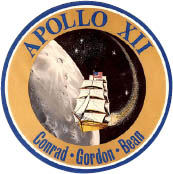

With less attention (and pressure) on Apollo 12, the second lunar landing, the flight took on a more casual feel, which was exemplified by its crew. Two-time Gemini astronaut Pete Conrad, already legendary for his sense of humor, was CDR; he was joined by his Gemini XI comrade Dick Gordon as CMP and rookie Alan Bean as LMP. The trio enjoyed driving matching gold-and-black 1969 Corvettes at Cape Canaveral and were known as an easygoing, fun crew. Bean had joined Conrad and Gordon on the backup crew for Apollo 9 after rookie astronaut Clifton Williams was killed in a T-38 crash in 1967. When they became the prime crew for Apollo 12, Bean, on his first space flight, suddenly became the fourth person scheduled to walk on the moon.
Apollo 12 was the first of the H missions, which called for precision landings, two-day stays on the moon, and two lunar EVAs. Its goals included a pinpoint landing on the Ocean of Storms, about 930 miles west of Apollo 11’s landing site, and the recovery of equipment from an unmanned Surveyor spacecraft, which had landed two and a half years earlier. The all–US Navy crew dubbed their CM Yankee Clipper and their LM Intrepid. Yankee Clipper had been chosen in a contest among NAR employees.
No matter how interesting the mission itself may have seemed, however, the launch was even more electrifying, quite literally. The Saturn V was cleared for liftoff at 11:22 a.m. (EST) on November 14, 1969, amid a lightning storm and heavy rain—the worst weather for any manned US launch. Among the guests were President Richard Nixon, First Lady Pat Nixon, and their daughter Tricia; Vice President Spiro Agnew; golfer Arnold Palmer; actor Jimmy Stewart; and Aga Khan IV, spiritual leader of a branch of Shia Islam.
The rocket disappeared into the gray rain clouds. Because the Saturn’s exhaust plume acted as a giant lightning rod, the vehicle was struck twice by lightning during the first minute of flight. Protective circuits took all three fuel cells and much of the CM’s instrumentation offline. The Saturn V’s Instrument Unit, however, was not affected, and the booster performed normally.

Launch: 11:22 a.m. (EST), November 14, 1969
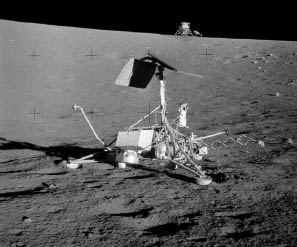
Lunar Landing: 1:54 a.m. (EST), November 19. Ascent: 9:25 a.m. (EST), November 20
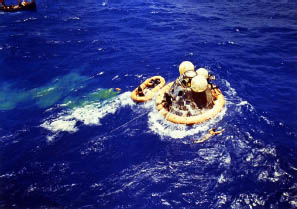
Splashdown: 3:58 p.m. (EST), November 24
At Mission Control in Houston, Electrical, Environmental, and Communications Manager (EECOM) John Aaron remembered the telemetry failure pattern from an earlier test, when a power supply had malfunctioned in the CSM Signal Conditioning Equipment (SCE). (The SCE converted raw signals from instrumentation to standard voltages for spacecraft instrument displays and telemetry.) Aaron’s call, “Try SCE to aux,” was relayed to the crew. Neither Flight Director Gerry Griffin, the CAPCOM, nor Conrad recognized the obscure switch. Bean, as the CSM systems engineer, remembered the switch from training a year earlier, when the same failure had been simulated. Aaron’s quick thinking and Bean’s memory saved what could have been an aborted mission. Bean switched the SCE to a backup power supply to put the fuel cells back online. With telemetry restored, the flight continued successfully.

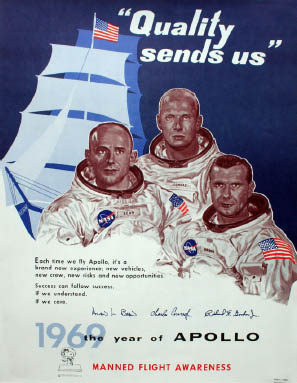
After a checkout in Earth orbit showed all systems operating normally, Apollo 12 was declared “go for TLI,” or translunar insertion.
After LM separation, the empty S-IVB third stage was to be sent into solar orbit. A small error in the Saturn’s guidance system, however, left it in Earth orbit until 1971. The stage has been in solar orbit since, although it was briefly recaptured in Earth orbit for about a year, after it was “discovered” by an amateur astronomer in 2002.
Gordon remained in lunar orbit as Intrepid landed on the northwest rim of Surveyor Crater, in the southeastern portion of the Ocean of Storms, on November 19, just 553 feet from Surveyor 3, which had landed in April 1967. When Conrad stepped from the last rung of the LM’s ladder onto Intrepid ’s footpad, he said, “Man, that may have been a small one for Neil, but that’s a long one for me!”
That initial descent was relayed back to Earth by a Westinghouse TV camera, the first time an astronaut’s descent to the surface was sent back in color. Not long after, as Bean was moving the camera to show the entire scene, he inadvertently pointed the lens toward the sun, destroying its low-light capability and rendering the camera useless. Bean finally struck the camera twice with a hammer, which briefly improved the picture, but the TV coverage was over.
During their two EVAs over almost eight hours, Conrad and Bean deployed the first Apollo Lunar Surface Experiments Package (ALSEP), collected about seventy-six pounds of lunar samples, and retrieved parts from the nearby Surveyor.
After a surface stay of a little more than one day and seven hours, the two launched from the moon to dock with Yankee Clipper. Intrepid ’s ascent stage was commanded to crash on the moon, and the resulting moonquake was registered by the ALSEP. The astronauts then performed their trans-Earth injection after forty-five lunar orbits, lasting eighty-six hours and fifty-six minutes.
On November 24, after just more than ten days, the astronauts splashed down in the Pacific Ocean and were recovered by the aircraft carrier USS Hornet .
Three days before launch, and after Apollo mission simulator runs, Pete Conrad, Dick Gordon, and Alan Bean pose with Bean’s 1969 Chevrolet Corvette in the parking lot of the Flight Crew Training Building at KSC on November 11, 1969. The three drove matching Corvettes, thanks to favorable lease deals for astronauts from Chevrolet dealer Jim Rathman, a Melbourne, Florida–based former race-car driver. (Rathman won the Indianapolis 500 in 1960.) Bean, an artist, liked the car’s appearance more than its performance. It is now owned by a collector in Texas, who has kept it original, including by maintaining the “LMP” on the fenders.
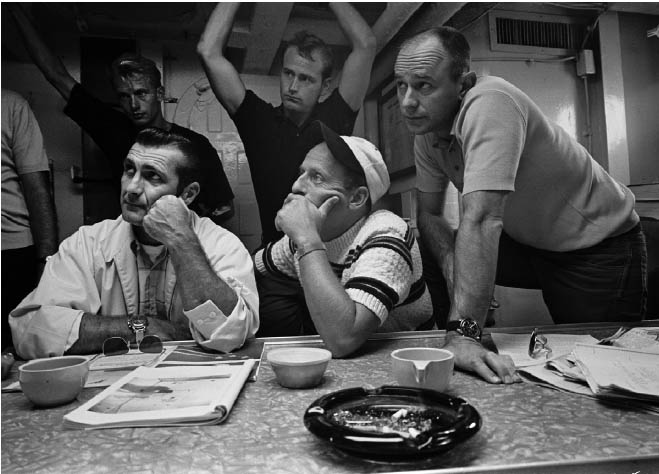
Gordon, Conrad, and Bean aboard MV Retriever before spacecraft egress and recovery training in the Gulf of Mexico near Galveston, Texas, on September 20, 1969. The Gordon and Bean photos below are also from this meeting.
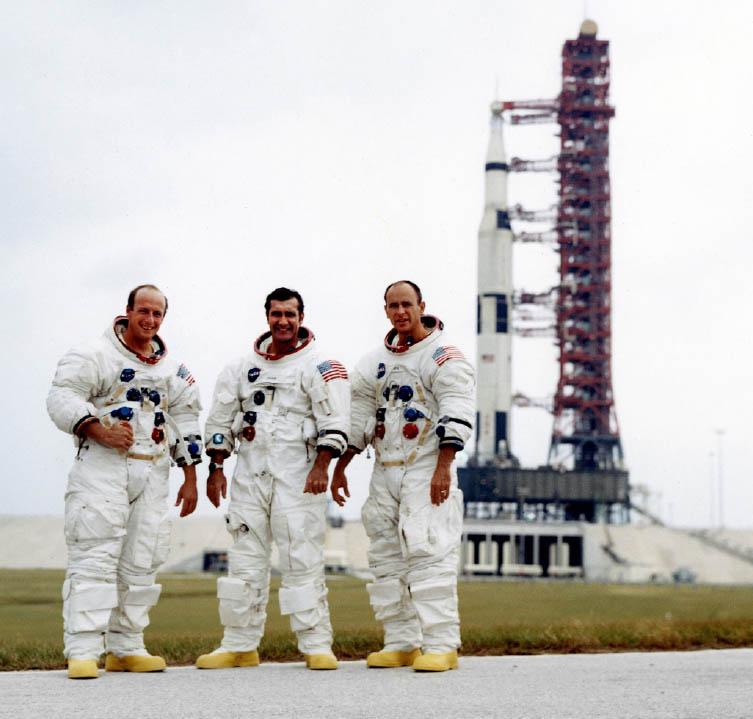
Conrad, Gordon, and Bean at Pad 39A on October 29, 1969, after the CDDT. As CMP, Gordon had a suit with fewer oxygen hose connectors; Conrad’s and Bean’s suits also connected to their lunar surface PLSS backpacks.
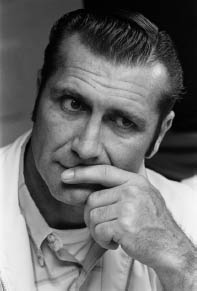
US Navy Cmdr. Pete Conrad during geology classroom training in Flagstaff, Arizona, on October 14, 1969. Conrad, thirty-nine, was considered the best pilot in the second group of astronauts. Apollo 12 was his third space flight, and his second as CDR. In 1973, he would lead a flight to rescue the Skylab space station.
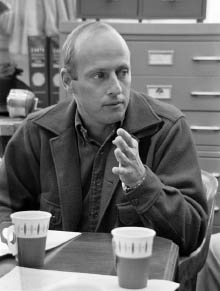
US Navy Cmdr. Dick Gordon, thirty-nine, had flown with Conrad on Gemini XI. Apollo 12 was his final space flight. In 1972, he became executive vice president of the New Orleans Saints, owned by John Mecom (whom he had met racing boats in 1965).
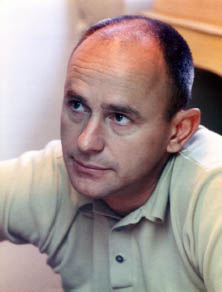
US Navy Cmdr. Alan Bean, thirty-seven, had applied for the second astronaut group, which included Conrad. He was accepted the following year, with Gordon.
The Saturn V’s S-IC first stage in the VAB’s transfer aisle, prior to stacking on May 7, 1969. Red protective covers are over its five F-1 Rocketdyne engines.
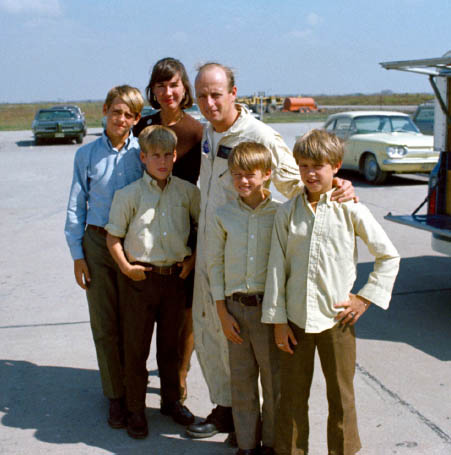
Jane and Pete Conrad with sons Peter, Andrew, Christopher, and Thomas at Ellington AFB after Conrad’s training run in the LLTV on October 25, 1969.
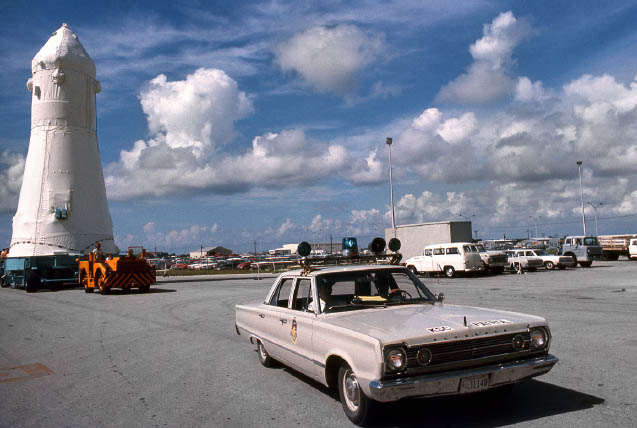
A KSC Security Patrol 1966 Plymouth Belvedere escorts the Apollo 12 spacecraft on June 30, 1969. The spacecraft is being towed toward the VAB from the MSOB. (photo by Tiziou News Service)
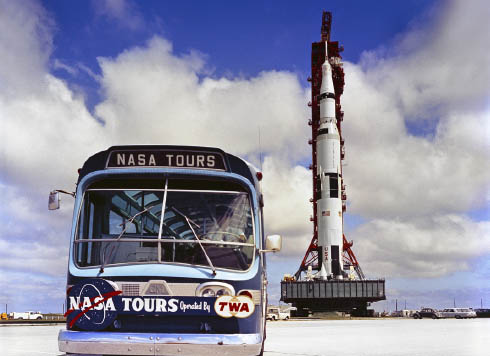
A TWA NASA Tours bus parks on the Saturn Causeway, approaching the perimeter of Pad 39A on September 8, 1969. Apollo 12 is being rolled toward the hardstand on ML-2. Public tours were not permitted this close to a launch vehicle.
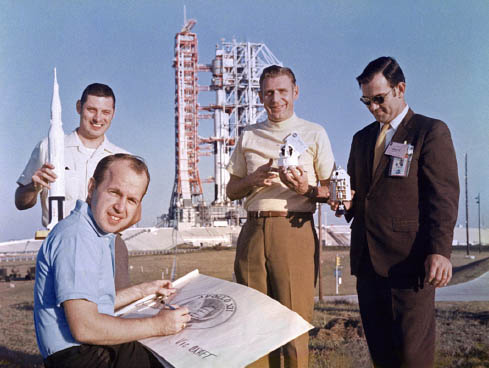
The astronauts chose the mission emblem design—by Victor R. Craft of the RCA Service Company in nearby Melbourne, Florida—from among two hundred submitted. Behind Craft are (left to right ) Walt Mack, editor of RCA’s magazine; Howard Enders of RCA corporate publicity; and a NASA tour guide. They hold Revell kit models. The MSS is in place to the right of the Saturn V at Pad 39A.
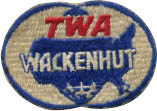
Technicians inspect the porch of the Apollo 12 LM ascent stage during closeout procedures in the MSOB on June 26, 1969. Black areas are foil sheets of the superalloy Inconel and nickel. (photo by Tiziou News Service)
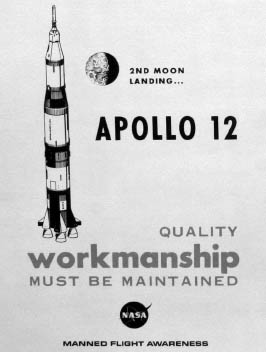
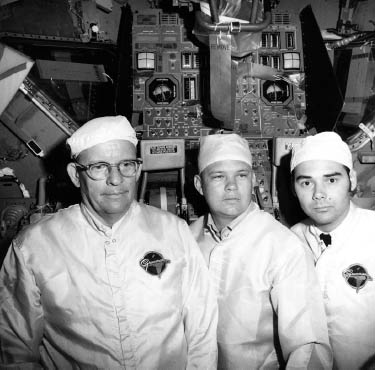
Grumman Aerospace technicians in the crew compartment of LM-6 on August 27, 1969, during closeout operations inside the SLA near the top of the Saturn V stack. They would leave with the “Remove Before Flight” ribbons on the LM’s windows and instrument panels (behind them ). Rollout to Pad 39A occurred twelve days later.

Technicians look over a processing schedule during closeout procedures on LM-6, in a test stand in the MSOB on June 26, 1969. An access control desk is at left. Metal alloy foil panels have not yet been installed on the rear of the ascent stage. (photo by Tiziou News Service)
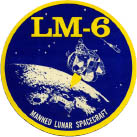
Bean, Gordon, and Conrad (displaying his crew’s US Navy pride) on the steps of the Command Module Simulator at the Flight Crew Training Building at KSC on October 22, 1969.
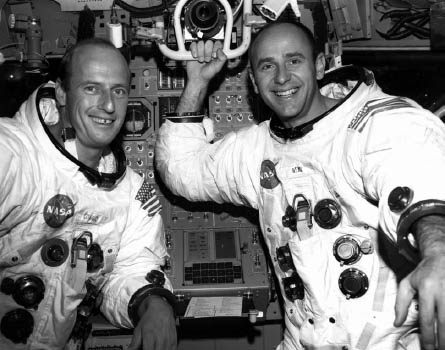
Conrad and Bean at their flight stations inside the Lunar Module Simulator at the Flight Crew Training Building on October 22, 1969. Above Bean’s hand is the Alignment Optical Telescope, used to determine the LM’s position based on stars and crew input. The lower panel between them contains the push buttons and data displays of the LM guidance computer.
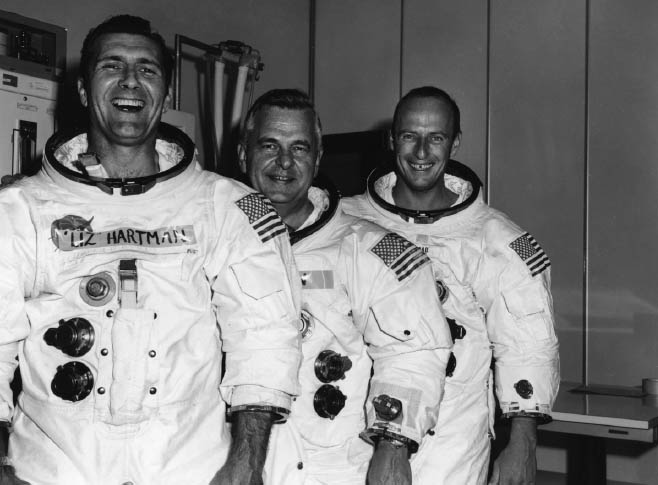
Gordon and Conrad pose in space suits with Launch Director Walter Kapryan (center ) in April 1969, as part of a twenty-seventh birthday joke on Elizabeth K. Hartman, who worked in Kapryan’s office at KSC.
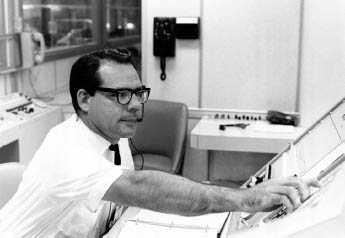
Lead Command Module Test Conductor Clarence “Skip” Chauvin mans a console in an Acceptance Checkout Equipment (ACE) station during prelaunch activities in the MSOB at KSC on November 7, 1969. The ACE system monitored 3,500 different spacecraft measurements.
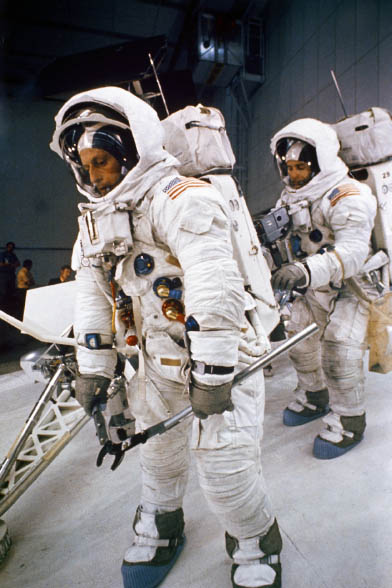
Conrad and Bean during lunar surface training with a mock-up of Surveyor 3, in the Flight Crew Training Building at KSC on September 30, 1969. Conrad holds the cutters used to remove equipment from the spacecraft.
The Saturn V’s three stages vent super-cold oxygen vapor—creating condensation clouds in the Florida humidity—during fueling operations at Pad 39A on November 13, 1969, the night before launch.
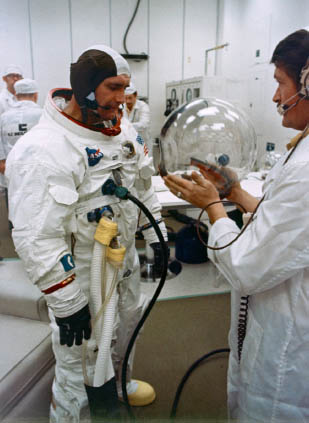
NASA suit tech Bill Prior assists Gordon during suiting on launch morning. Suit tech John Bolan is to the right of Gordon.
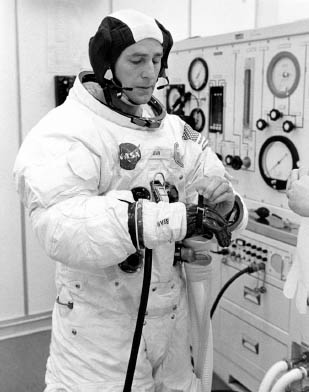
Bean adjusts a glove while suiting on launch morning.
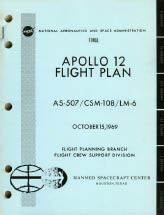
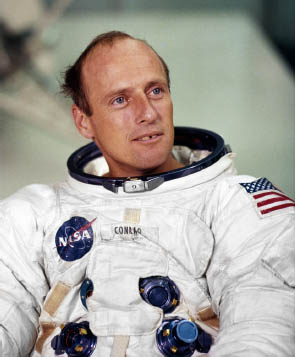
Conrad during a session with the news media following an EVA training exercise, at the Flight Crew Training Building at KSC on September 30, 1969.
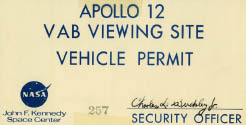
Management row in Firing Room 2 on launch morning. Front row, left to right : Jack King, Jim McDivitt, John Williams (hidden), Paul Donnelly, Walt Kapryan, and Andy Pickett, director of mechanical and propulsion. Deputy Director of Launch Vehicle Operations Ike Rigell stands at the end of the console. Back row, left to right : KSC Director Kurt Debus, Tom Stafford, NASA Deputy Administrator George Low, and Rocco Petrone (hidden behind Kapryan). Al Bransford is the film cameraman at right.
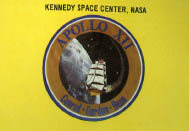
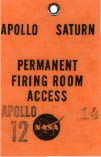
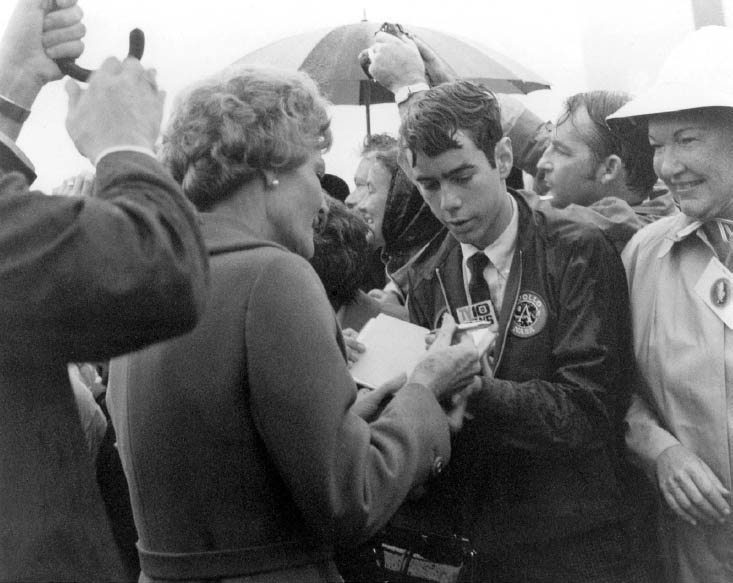
On launch morning, First Lady Pat Nixon signs an autograph for John Bisney, along the rope line leading from President Nixon’s helicopter landing pad to the VIP viewing stand on the north side of the VAB. Bisney had written to Nixon requesting a launch invitation; only later did the president decide to attend.
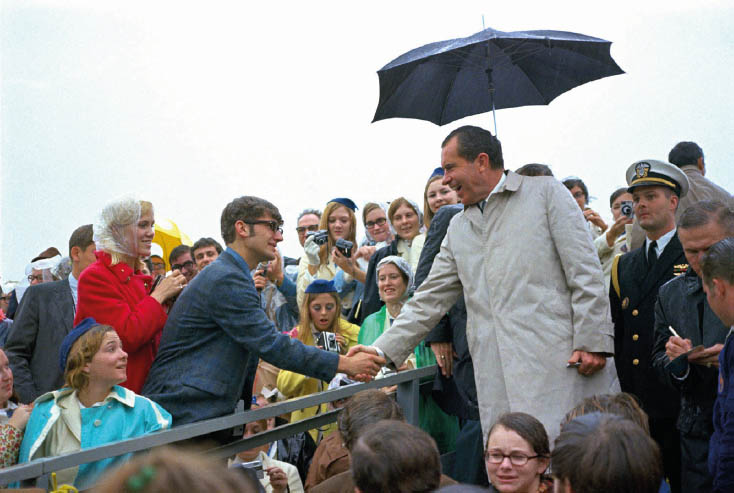
President Nixon greets guests at the VIP viewing stand on launch morning. His naval aide behind him, Lt. Cdr. Charles R. Larson, became a four-star admiral. Astronaut Frank Borman, who had been assigned as a liaison to the White House, signs an autograph at right. The following August, Nixon sent Borman on an unsuccessful twelve-nation tour to seek the release of US POWs held by North Vietnam. Nixon was the first incumbent president to attend a launch from KSC or Cape Canaveral. He was also the only one to do so, until then-president Bill Clinton attended the STS-95 Space Shuttle launch of John Glenn in 1998.
Apollo 12 slowly roars away from Pad 39A at 11:22 a.m. (EST) on November 14, 1969.
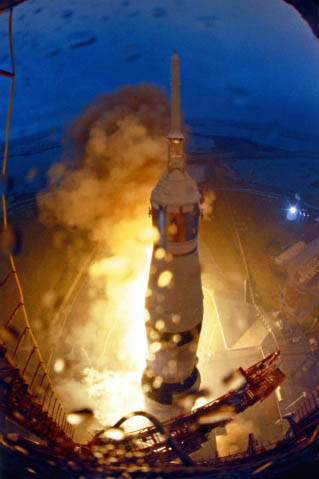
Raindrops dot the lens of a camera at the 360-foot level of the LUT (near the top), looking south. Lightning struck the launch vehicle twice less than one minute after liftoff.
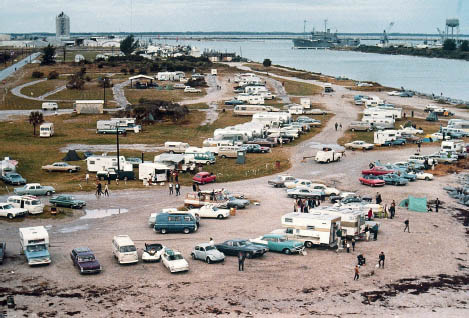
Some of the estimated three hundred thousand launch spectators line the water at Jetty Park Campground, 13.5 miles south of Pad 39A. This was the northernmost public viewing location along the Atlantic. The photograph’s view looks west into Port Canaveral, with most vehicles pointing north-northeast. Viewing spots along US Route 1 and the Indian River in Titusville (to the north) were slightly closer, at 12 miles west of the pad. The VIP stands at the VAB, by comparison, were 3 miles west of the launch.
Bean takes a photo of the Suprathermal Ion Detector Experiment (SIDE) during EVA 1 on November 19. The small cold cathode ion gauge, which failed within fourteen hours, is to the left of the SIDE; the ribbon cable connecting SIDE to the ALSEP Central Station runs to the right. The blue “fog” is a dust smudge.
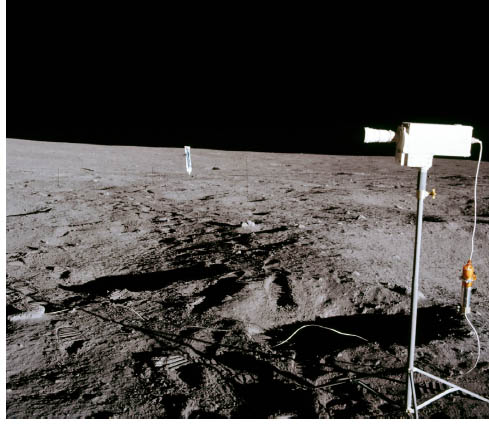
A view looking north of the LM during EVA 1, with the SWCE at center and the burned-out Westinghouse color TV camera at right. The camera, painted white for thermal control, was from the Apollo 10 CM. The orange area covers an adapter, which was required because the camera’s connector did not match the extension cable back to the LM. The cable was designed for a black-and-white camera; the late decision to use the color camera precluded a more elegant solution.
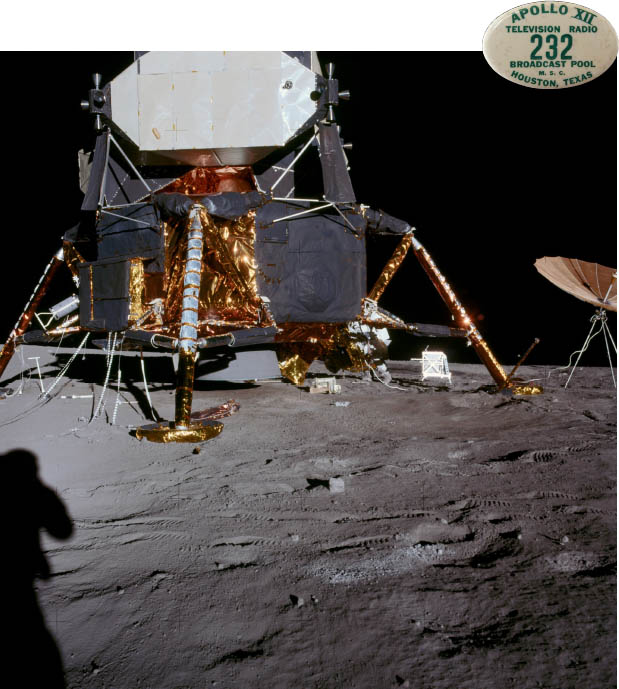
The first in a series of photos by Bean, taken for a panorama during EVA 1 on November 19. The photo shows the rear of Intrepid , with a lunar contact probe bent upward at right, near the portable S-band antenna. Conrad works at the Modularized Equipment Stowage Assembly (MESA), just right of the LM. The gray cylinder at left is the cask for the plutonium-238 fuel capsule, used to power the ALSEP for a year. Its SNAP-27 (Systems Nuclear Auxiliary Power) generator was the first nuclear electrical power source on the moon. It remained functional when the ALSEP program was discontinued in 1977.
Bean’s photo during EVA 1 on November 19, looking south toward Intrepid . The SWCE is in the foreground and the portable S-band antenna points toward Earth. Conrad, at right, is taking a series of panoramic photos, which would include Bean. Surveyor Crater is behind Intrepid at left.
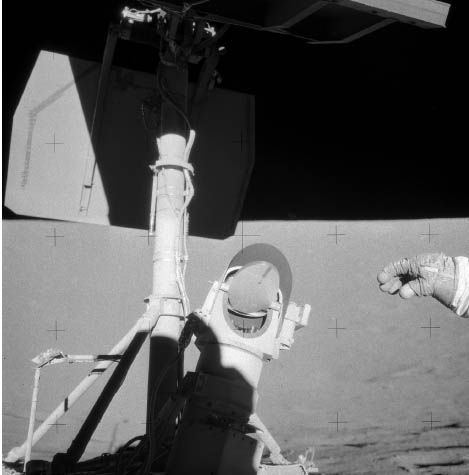
Conrad reaches toward the Surveyor 3 television camera assembly during EVA 2 on November 20. With one finger, he has already drawn a line in the dust on the mirror, which reflected images to the camera below. Surveyor’s two solar power panels are at top.
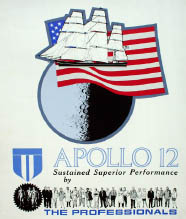
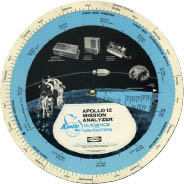
“Mission Analyzer” promotional item from the Raytheon Company, which built the Apollo guidance computer designed by MIT
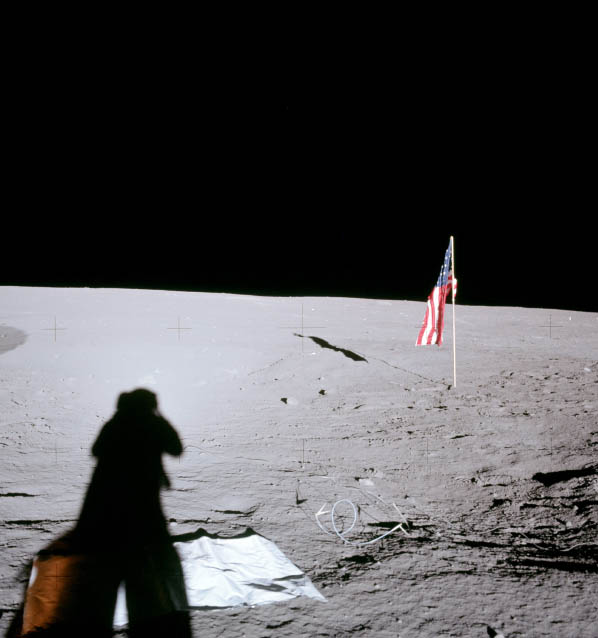
Bean’s photo, looking southwest from the LM, of the US flag, with a partial shadow from the portable S-band antenna at left. The flat object in the foreground is the S-band antenna cover.
Divers from UDT-13 attach the flotation collar around Yankee Clipper during recovery operations, just three miles from the recovery ship, on November 24. The CM’s three flotation bags are inflated. Recovery personnel often kept as souvenirs the small pieces of gold Mylar foil that peeled off the spacecraft.
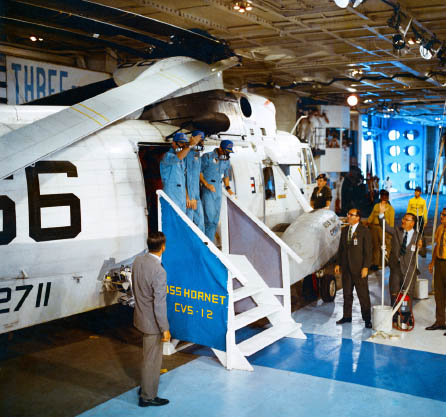
Wearing respirators to prevent the release of any biohazards from the moon, Gordon, Bean, and Conrad step from their Sea King recovery helicopter onto the hangar deck of USS Hornet , an antisubmarine warfare support aircraft carrier, on November 24. To the right of the steps is John Stonesifer, chief of MSC’s Recovery Systems Branch, Landing and Recovery Division.
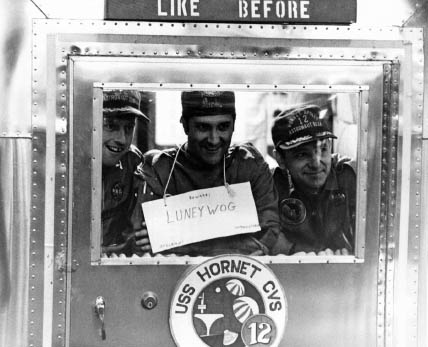
Conrad and Bean label Gordon a “luneywog” in the MQF on November 27. (In a navy initiation rite, first-time equator-crossers are dubbed “pollywogs.”) Gordon wears his uniform backward for the occasion.
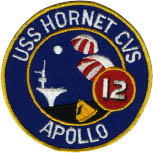

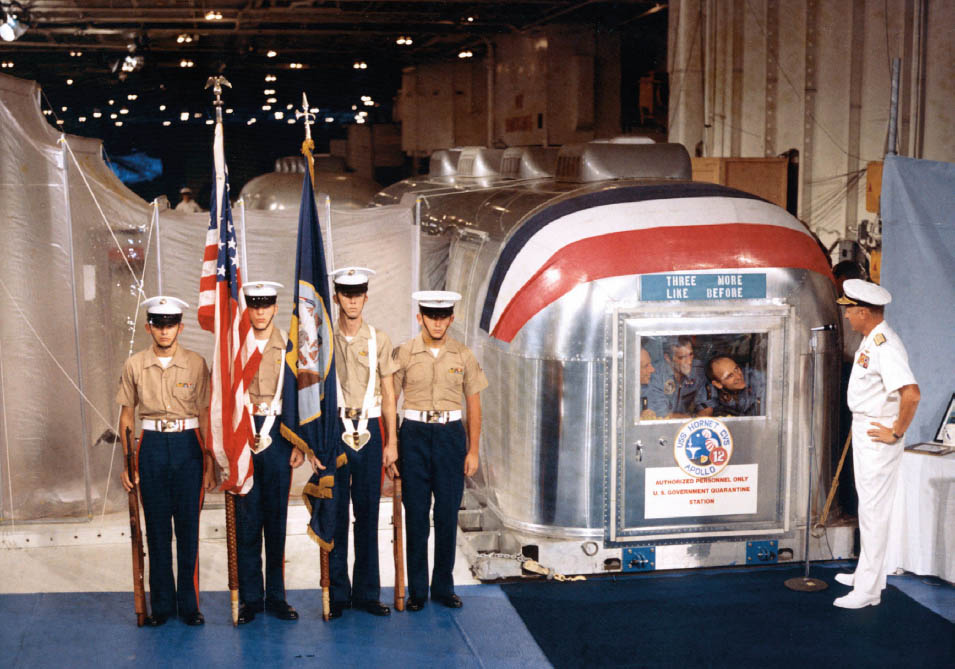
The crewmen, inside their MQF, are welcomed aboard the Hornet by Rear Adm. Donald C. Davis, commander of the Pacific Manned Spacecraft Recovery Force, on November 24, 1969. A Marine Corps color guard is at left. The Hornet was decommissioned seven months later, and is now on display in Alameda, California. This MQF is displayed at the US Space & Rocket Center in Huntsville, Alabama.
Apollo 12’s MQF is backed into the loading dock of Bldg. 37 at MSC, after arriving by C-130 at Ellington AFB on November 29. Two shipments of lunar rocks had arrived four days earlier, sent via Pago Pago in American Samoa. The $7.8 million LRL contained the lunar lab, biological facilities, crew isolation area, a gas analysis lab, and a radiation-counting lab.
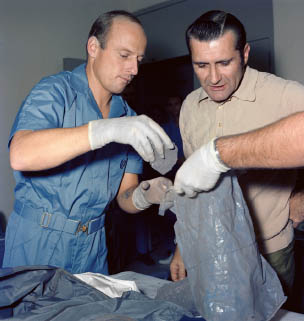
Conrad and Gordon examine lunar samples in the LRL on November 29. The crew returned with more than seventy-five pounds of material, three times the amount from Apollo 11.
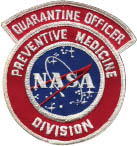
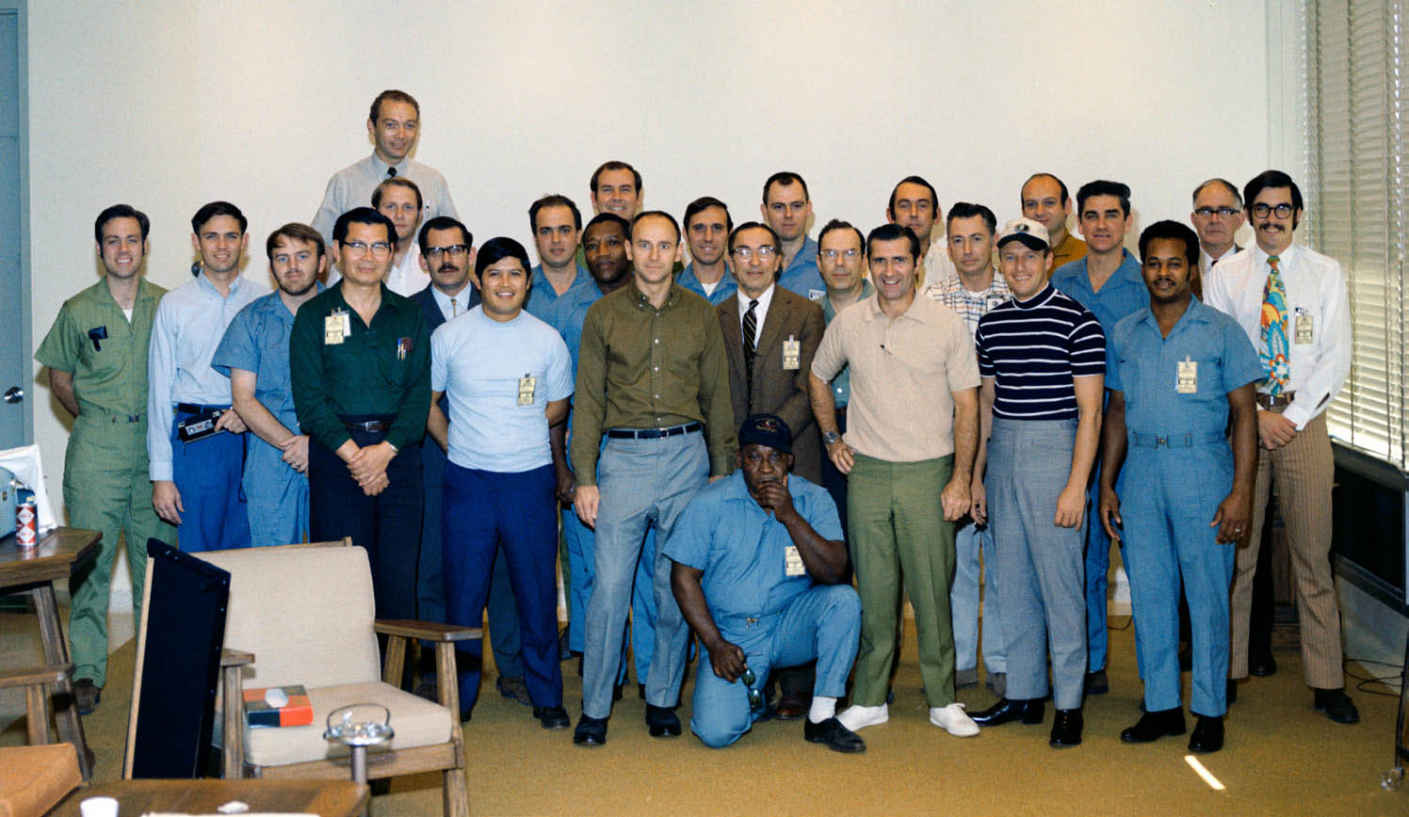
Bean, Gordon, and Conrad pose with the LRL staff, just before being released from isolation on December 10.
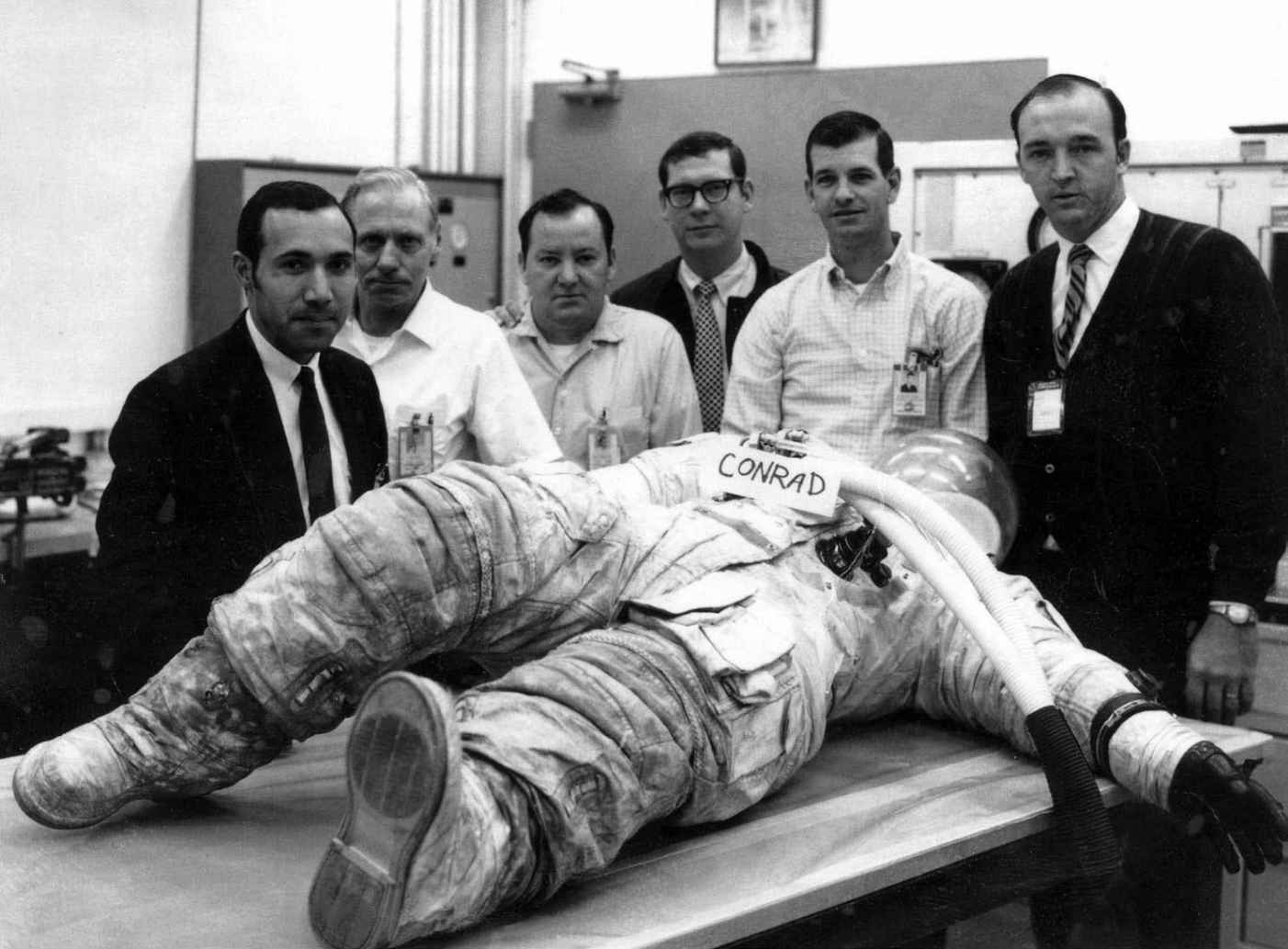
Conrad’s suit undergoes inspections in Room 2020 of Bldg. 7 at MSC. Left to right: T. J. Tirado and Jay Aljoe of ILC; unidentified; Gene Nitch and Dick Sandrich of NASA; and ILC’s Dan McCarthy.